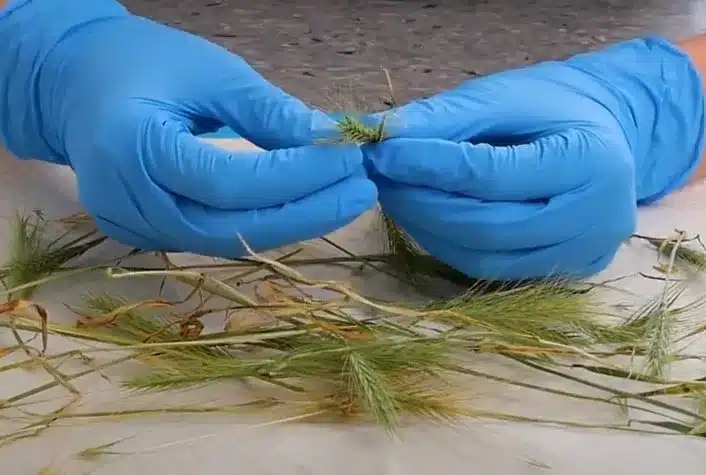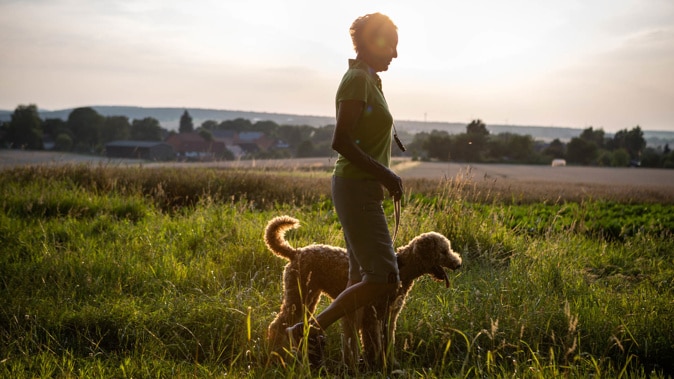The Danger of Barley Grass Seeds for Dogs: What Every Dog Owner Should Know
In This Article...
THE OVERVIEW...
The Dangers of Barley Grass Seeds for Dogs
What Are Barley Grass Seeds and Why Are They Dangerous for Dogs?
Understanding Barley Grass and Its Seeds
Barley grass, a common plant found in many regions, produces seeds that can be detrimental to dogs. These seeds are equipped with sharp barbs that allow them to easily penetrate the skin, fur, and other tissues of your dog. When dogs play in the long grass, the seeds can become lodged in their coat, potentially leading to various health complications. It is crucial for dog owners to be aware of these grass seeds and the dangers they present, especially during the spring and summer months when they are most prevalent.
These barbed seeds are not just an annoyance; they can migrate within your dog’s body, finding entry points through the paws, coat, or even the ears. The design of the barley grass seeds allows them to burrow deeper into the skin, which increases the risk of infections and other serious issues. Dog owners need to be vigilant during outdoor activities, ensuring their pets are kept away from areas with lots of barley grass.
How Barley Grass Seeds Can Penetrate Your Dog’s Body
The way barley grass seeds can penetrate your dog’s body is alarming. As these seeds come into contact with your dog, they can easily embed themselves in various parts of the body. Dogs often lick or scratch at these irritating seeds, which can inadvertently cause them to migrate deeper into the skin or even into sensitive areas such as the paws, arm puts or ear drum. This movement can lead to painful complications and requires immediate attention from a veterinarian.
Furthermore, the seeds can become lodged between the toes or in the paws, making it uncomfortable for your dog to walk. If a seed is not removed immediately, it may cause inflammation and lead to severe pain. Owners should check their dogs regularly, especially after walks in grassy areas, to ensure no seeds are stuck in their fur or paws. Being proactive in monitoring your dog’s condition can help avoid serious health issues associated with barley grass seeds.
Signs to Watch for When Dogs Encounter Barley Grass Seeds
Common Symptoms of Grass Seed Exposure
When dogs come into contact with barley grass seeds, several symptoms may arise. Common signs of grass seed exposure include excessive licking, scratching, and discomfort. You may notice your dog favouring a particular paw or area of the body, indicating a possible embedded seed. Additionally, symptoms such as swelling, redness, or discharge from the skin can signal that a seed has penetrated your dog’s coat and skin.
Other signs include behavioural changes, such as increased agitation or reluctance to walk. If the seed has migrated to sensitive areas, your dog may exhibit signs of pain or distress. As a dog owner, being aware of these symptoms is vital for early detection and treatment of potential grass seed problems. Promptly addressing these issues can help avoid further complications and ensure your dog remains healthy and happy.
When to Contact Your Veterinarian
Knowing when to contact your veterinarian is crucial for ensuring your dog’s health. If you notice any signs of grass seed exposure, such as swelling or persistent discomfort, it’s important to seek veterinary advice. Immediate attention is necessary if your dog exhibits severe symptoms, including difficulty breathing or unusual behavior. These could indicate that the seed has penetrated a sensitive area and requires urgent care.
Additionally, if you suspect that a seed has embedded itself in your dog’s coat or skin, do not hesitate to reach out to your vet. Early intervention can prevent serious complications, such as infections or the need for surgery to remove the embedded seed. Your veterinarian will provide guidance on how to proceed, ensuring your dog receives the necessary care and prompt attention to avoid further issues.
Signs of Embedded Grass Seeds in Long-Haired Dogs
Long-haired dogs are particularly susceptible to the dangers of barley grass seeds, as their fur can easily conceal embedded seeds. Owners should be vigilant and regularly inspect their long-haired dogs for signs of grass seed exposure. Look for areas of irritation or unusual grooming behavior, as these may indicate that a seed has become lodged in their coat or skin. Additionally, check for signs of inflammation or discharge, which could signal an infection.
When examining your long-haired dog, pay close attention to areas where grass seeds are more likely to become trapped, such as the paws, belly, and behind the ears. If you find any unusual lumps or bumps in the fur, it’s essential to investigate further to ensure that no seeds are embedded. Being proactive in checking your long-haired dog can make all the difference in preventing potential health issues related to barley grass seeds. Regularly brushing is a helpful strategy for not only preventing knots in your dogs fur but also checking for embedded seeds.
How to Prevent Your Dog from Coming into Contact with Grass Seeds
Things Dog Owners to Consider During Spring and Summer
During the spring and summer months, dog owners need to be more vigilant to prevent their pets from coming into contact with barley grass seeds. One effective strategy is to avoid walking in areas known to have high grass seed prevalence. In Christchurch, the council has identified Bexley parks and the Red Zones as areas prevalent with Barly Grass. While in season, it is best to stick to well-maintained paths and avoid long grass where seeds are likely to be found. Additionally, keeping your dog on a leash can help you maintain control and steer clear of problematic areas.
Another preventative measure is to regularly groom your dog, especially after outdoor activities. Brushing your dog’s coat can help remove any seeds that may have become lodged in their fur. If you notice any seeds stuck in their coat or paws, it’s essential to remove them promptly. Taking these precautions can significantly reduce the risk of your dog encountering grass seeds and help ensure a safe and enjoyable outdoor experience.
Grooming Tips to Reduce Risk of Seed Embedding
Proper grooming techniques can be instrumental in reducing the risk of grass seeds embedding in your dog’s coat. Regular brushing helps to keep your dog’s fur short around the paws and other areas where seeds are likely to get trapped. By maintaining a well-groomed coat, you can minimize the chances of seeds becoming lodged in the fur. Additionally, consider using dog-safe combs to gently detangle any mats, which are often started by embedded seeds.
Bathing your dog after walks in grassy areas can help wash away any seeds that may have attached themselves to the coat. Pay special attention to areas between the toes, under arms and around the ears, as these are common entry points for grass seeds. By integrating these grooming tips into your routine, you can significantly lower the risk of your dog suffering from the dangerous effects of barley grass seeds.
What to Do If Your Dog Has Grass Seeds Stuck in Their Fur or Paws
Steps to Take Immediately After Suspecting Seed Contact
If you suspect that your dog has come into contact with grass seeds, it is essential to act quickly. Begin by calmly checking your dog’s coat and paws for any visible seeds. If you find any, carefully remove them using your fingers or a pair of tweezers. Be sure to check all areas, including between the toes, under the belly, and around the ears, where seeds are likely to hide.
After checking for seeds, monitor your dog for any signs of discomfort or irritation. If you notice any swelling, redness, or unusual behavior, it may be time to contact your veterinarian for further guidance. Taking immediate action can prevent potential complications and ensure your dog receives the necessary care to address any issues arising from grass seed exposure.
How to Find and Remove a Seed from Your Dog
Locating and removing a grass seed from your dog requires patience and care. Begin by gently examining your dog’s coat, focusing on areas that often catch seeds, such as the paws, are pits, and ears. If you find a seed, take your time to ensure you can remove it completely without causing additional harm. Using tweezers can help grasp the seed firmly for extraction.

After removal, it’s essential to clean the area to prevent infections. Use a mild antiseptic or warm water to cleanse the area where the seed was lodged. Monitor your dog for any signs of irritation or infection, and if complications arise, be sure to consult your veterinarian. Being diligent about finding and removing grass seeds can help keep your dog healthy and comfortable.
Seek Help from a Professional Groomer
If you are unsure how to remove grass seeds from your dog’s fur or if your dog has a long coat that makes it challenging to spot them, seeking help from a professional groomer can be beneficial. Groomers are experienced in handling various dog breeds and can quickly identify and remove any embedded seeds. They can also provide valuable advice on maintaining your dog’s coat to reduce the risk of future encounters with grass seeds.
In addition, professional groomers can help you establish a grooming routine that suits your dog’s needs, ensuring their coat remains healthy and free of debris. By enlisting the help of a groomer, you can alleviate the stress of dealing with grass seeds and protect your dog from potential health issues associated with barley grass exposure.
If you’re unsure and want a second opinion, pop in and see Shannon and Hannah at Kuri to see if they can help. We also recommend having a regular groom during Summer, even if it is just to check your pup over. Book here.
The Potential Consequences of Not Addressing Grass Seed Issues
Risks of Leaving Seeds Embedded in Your Dog’s Body
Failing to address the presence of embedded grass seeds in your dog’s body can lead to severe health complications. If a seed is left untreated, it can migrate deeper into the skin, potentially causing infections or inflammatory reactions. Depending on where the seed has penetrated, it may affect vital organs, leading to serious consequences that could jeopardize your dog’s well-being.
Moreover, the discomfort caused by an embedded seed can lead to behavioral changes in your dog. They may become more withdrawn or exhibit signs of pain, such as excessive licking or reluctance to engage in activities they once enjoyed. Regularly monitoring your dog for signs of embedded grass seeds is crucial to ensuring their overall health and happiness.
Possible Surgical Interventions for Severe Cases
In severe cases where a grass seed has caused significant damage or infection, surgical intervention may be necessary. A veterinarian may need to perform surgery to remove the embedded seed, especially if it has migrated to sensitive areas such as the chest cavity or ear drum. These procedures can be invasive and may require a longer recovery period, increasing the stress on both the dog and the owner.
Additionally, the costs associated with surgical interventions can be a burden for pet owners. Therefore, taking proactive measures to prevent grass seed exposure is essential. Regular grooming and being cautious during outdoor activities can significantly reduce the risk of encountering grass seeds and the potential need for surgical procedures.
Long-Term Health Implications for Affected Dogs
Dogs that suffer from embedded grass seeds may face long-term health implications, especially if the seeds are not removed promptly. Chronic infections can lead to ongoing pain and discomfort, affecting your dog’s quality of life. Additionally, prolonged exposure to embedded seeds can lead to irreversible damage to surrounding tissues or organs, resulting in lasting health issues.
Furthermore, some dogs may develop sensitivities or allergies to grass seeds, making future outdoor activities more challenging. By recognizing the dangers associated with barley grass seeds and addressing them proactively, dog owners can help mitigate these risks and ensure their pets lead healthy, fulfilling lives.
When to Seek Help from a Vet
Knowing when to seek professional help from a veterinarian is crucial for your dog’s health. If you notice any signs of discomfort, such as persistent licking, swelling, or unusual behavior, it’s essential to consult your vet. This is especially important if you suspect that a grass seed may be embedded in your dog’s coat or skin, as veterinarians can provide the necessary care and expertise to address these issues.
Additionally, if your dog exhibits severe symptoms like difficulty breathing or signs of internal discomfort, immediate veterinary assistance is warranted. Being proactive in seeking help can prevent further complications and ensure your dog receives the care they need. Regular check-ups and open communication with your veterinarian can also help you stay informed about your dog’s health and any potential risks associated with barley grass seeds.
FAQs
Are there treatments available for dogs affected by barley grass seeds?
Yes, treatments vary depending on the severity of the situation. If not too deeply embedded, an experienced groomer can remove the seed before any treatment for any resulting infections or complications is needed.
Where can I seek help if I suspect my dog has a barley grass seed issue?
You should contact your vet or groomer immediately or visit a local animal care facility, for professional help.
What happens if a barley grass seed gets inside the body of my dog?
If a barley grass seed gets inside the body, it can cause infections, abscesses, or other serious health issues. In such cases, your vet may be able to remove the seed surgically.
How can I check my dog for barley grass seeds after a walk?
To check your dog, thoroughly inspect their coat, especially in areas where seeds may be caught, such as between the toes, in the ears, pits of legs, and around the face.
What are the symptoms that may indicate a barley grass seed has entered my dog's body?
Symptoms may include excessive scratching, swelling, discharge from the ears or eyes, and signs of discomfort. If you notice these signs, immediate veterinary attention may be required.
What should I do if I find the seed in my dog's coat?
If you find the seed in your dog's coat, carefully try to remove it, but if it seems lodged or difficult to reach, you should contact your vet or groomer for assistance.
How can I prevent my dog from catching barley grass seeds?
To prevent your dog from catching seeds, regularly check their coat after walks in grassy areas and keep their hair short around the paws and ears. Opt for different walking spots during peek seasons.
What breeds are particularly at risk from barley grass seeds?
While all dogs can be affected, breeds like spaniels, are particularly at risk due to their long ears and fur, which can trap seeds.
What should dog owners be warned about regarding barley grass seeds?
Dog owners are warned that barley grass seeds can pose a significant danger to their pets, particularly if they become lodged inside the body.


